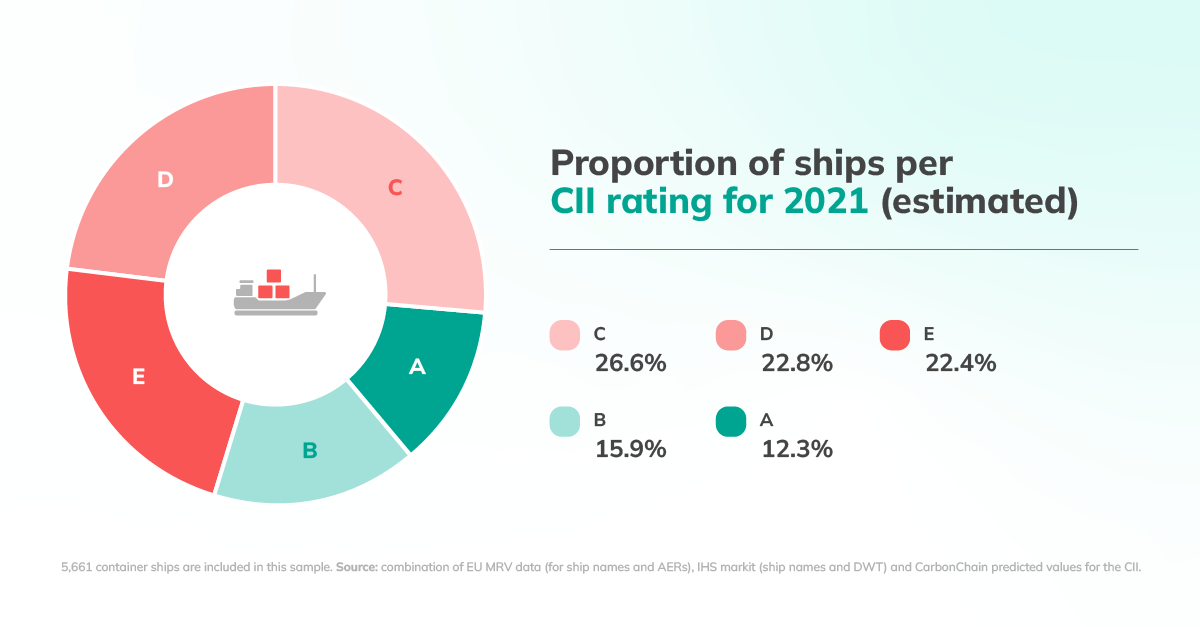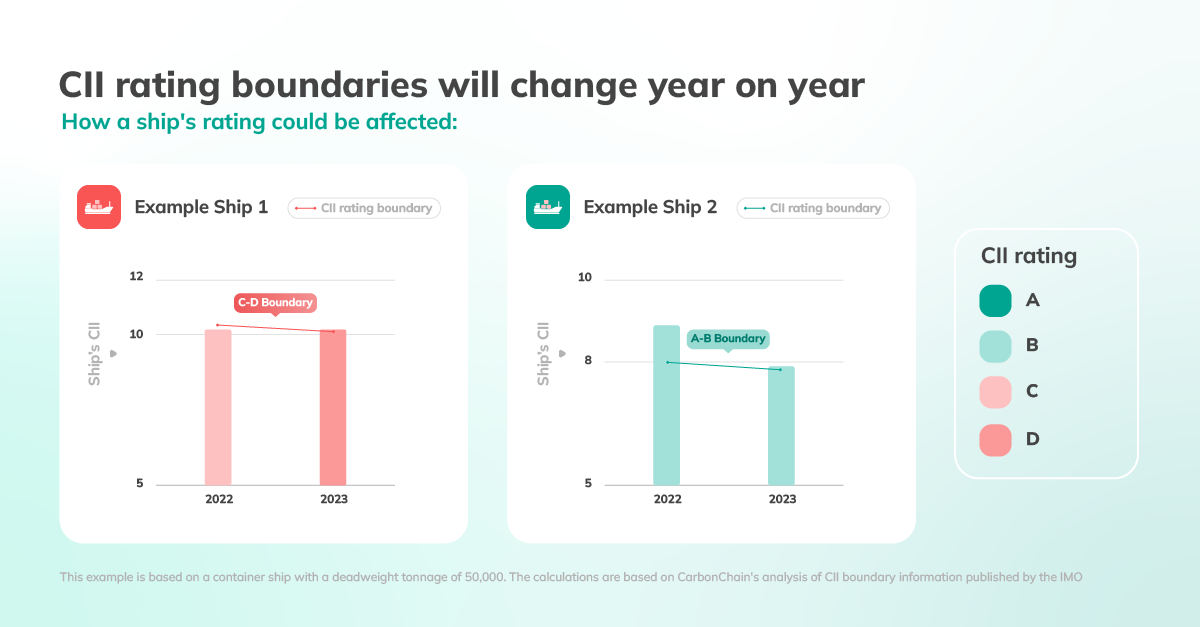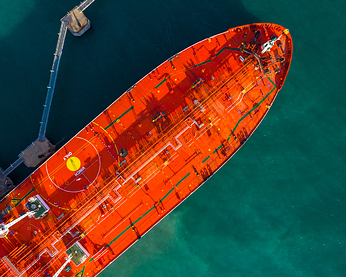New regulations for shipping emissions are here. All ships above 5,000 gross tons are now subject to carbon reporting rules and ratings by the International Maritime Organization (IMO), which includes a Carbon Intensity Indicator (CII) rating from A-E.
What does this mean in practice and how does it impact your ships, charters or supply chains? Here’s what you need to know:
What is the IMO CII?
The CII rating is part of the IMO’s new set of mandatory carbon reporting and rating measures. Since 1 January 2023:
- Ships must report their Energy Efficiency eXisting Ship Index (EEXI) and their annual Carbon Intensity Indicator (CII). See details on the required metrics and calculations below;
- The IMO will assign a CII score (from A-E). Low performing ships will have to prepare a corrective action plan;
- Each year it will become harder for a ship to improve its rating (see examples below).
These new measures are part of the IMO’s commitment to reduce the carbon intensity from all ships by 40% by 2030.
Who is affected by the IMO CII?
Ships owners need to undertake the calculations and reporting. But, all businesses should assess how ships in their supply chains perform against the CII scores, in order to take early action to improve ratings, and manage potential risks (such as the impact on logistics providers’ operations and costs).
A significant number of ships could be scored poorly. 1 in 2 ships is likely to receive D or E ratings, according to CarbonChain’s sample analysis. With only 1 in 8 expected to achieve an A, there’s a clear opportunity for more companies to show leadership on reducing the carbon intensity of their logistics activities.

Step-by-step: How will the new IMO CII measures work?
Step 1: Reporting
From 2023, shipping companies must submit two pieces of information to the IMO annually:
- Energy Efficiency eXisting Ship Index (EEXI): This is a ship’s energy efficiency metric (CO2 emissions per cargo ton and mile) compared to a baseline, based on ship design (installed engine power, transport capacity and ship speed).
- Carbon Intensity Indicator (CII): This measures the efficiency of a ship’s transportation of goods or passengers. The IMO accepts calculations based on the Annual Efficiency Ratio (AER): the CO2 emissions of a ship per unit of nominal transport work (the product of a ship’s capacity and total distance traveled in nautical miles). Voyage and fuel consumption data must be collected over the year for these calculations.
Step 2: Rating
From 2024, the IMO will give ships CII ratings (A-E, where A is best / less carbon-intensive), in line with its guidelines. The performance level will be recorded in a ‘Statement of Compliance’ to be included in the ship’s Ship Energy Efficiency Management Plan (SEEMP).
Step 3: Decarbonizing
- E-rated ships will have to submit a corrective action plan to achieve a C or above;
- D-rated ships will have 2 further years to improve before needing to submit a corrective action plan;
- For C, B or A ratings, businesses should voluntarily strive to reach A across the board as soon as possible, to demonstrate climate ambition and alignment with global benchmarks and standards.
Each year, it becomes harder for a ship to improve its CII rating
Rating boundaries will become more stringent (lowering by around 2% each year).
This means a container ship that scores a C in 2022 could score a D in 2023 without changing its CII (let’s assume the CII value is 10.3). This is because the C-D boundary for a 50,000 DWT container ship moves from 10.4 to 10.2 in 2023.
To take another example: a container ship’s 2022 rating may be a B. In 2023, it may reduce its carbon intensity by 11%, which would have been enough for an A in 2022. However, due to the boundary changes in 2023, it will once again receive a B.

How to improve a ship’s CII score
Common ways to reduce shipping emissions intensity include:
- Run ships on 100% renewable energy. Where 100% renewables is not yet possible, alternatives fuels like liquified natural gas usually result in lower emissions;
- Optimize the designs of hull, rudder and propeller designs for efficiency.
Get ready with CarbonChain’s CII calculator
Manage risk and decarbonize your shipping activities by calculating your CII ratings in advance.
CarbonChain’s CII calculator can reveal your ships’ ratings, or those in your supply chain. The tool also presents alternative ships with better CII ratings, so you can switch now to reduce your emissions, or work with ship owners on carbon strategies.

An illustrative example of a company’s ship rating analysis by CarbonChain. The calculated CIIs and ratings are either derived from EU MRV data or predicted using CarbonChain’s AI-powered models. As deadweight tonnage increases, the CII rating boundaries change (generally lowering). If you don’t have your CII factors, CarbonChain can undertake the calculations using our database of vessel-specific AER factors which covers nearly 100,000 ships worldwide.
In less than a year, shipping will also be included in the EU Emissions Trading System (ETS). CarbonChain can help you prepare for all climate regulations in one cloud-based platform, helping you benchmark against the CII, as well as other global standards like the Poseidon Principles and Sea Cargo Charter.
 Request your CII calculation
Request your CII calculation
An expert from our team will get in touch as soon as possible.
can also provide accurate carbon footprinting for your whole supply chain — not just shipping, but every asset, from mine to port and beyond.
- SEO Powered Content & PR Distribution. Get Amplified Today.
- Platoblockchain. Web3 Metaverse Intelligence. Knowledge Amplified. Access Here.
- Source: https://www.carbonchain.com/blog/the-imo-carbon-intensity-indicator-cii-what-is-it-and-how-to-prepare